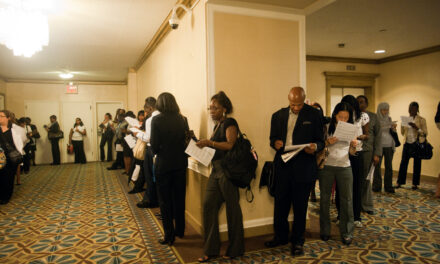2025’s markets have been characterized by volatility and unpredictability — as President Trump’s transformative new agenda leaves investors scrambling to adapt.
In this kind of uncertain market, the power of a reliable leading indicator becomes immeasurable…
And jobless claims (which are my specialization) just so happen to be the best leading economic indicator out there.
So where does the job market say we’re headed in the second half of 2025?
Watch today’s video below to find out:
Video transcript:
Hi, I’m Andrew Zatlin … and on today’s Moneyball economics, we’re going to do a deep dive into jobless claims.
Why jobless claims? Well, simply, they are the best leading economic indicator out there. And where the economy goes, that’s where the stock market’s going to go and the bond market. So we want to really take a look at what the signals are being thrown out by the jobless claims now…
Right now, the number came in and it was pretty good and in general, the stock market and the bond market, they’re not pricing in any form of economic slowdown. They don’t see it. CPI, inflation, it’s in. Check payrolls came out last week. They were pretty good. jobless claims? They came down a little bit. All these signals at the headline number would seem to indicate that the economy’s chugging along, but
I’m here to say I disagree. I think the economy is soft and it’s going to get a little softer…
Now, one of us is right, one of us is wrong.
I’m going to lay out my case. Let’s start for example, with the payroll number. It came out, it was good, much better than I expected, except there are two parts to payrolls. There’s the public sector, government, public schools, and there’s the private sector. The thing that actually makes the economy go around.
Well, I was actually very correct on what was going on in the private sector. Almost no jobs were added. In fact, the payrolls were strong because there were more teachers hired during summer vacation. See, the secret to the payrolls was we had 80,000 more public education hires. Basically what happened was they screwed up on the calendaring of summer break and somehow that bled in bottom line.
The private sector’s not hiring. Companies are not hiring. That’s my concern. We have to peel back these numbers and now let’s do it with jobless claims…
Jobless claims. What are we seeing? Well, there are two parts to jobless claims, just like there were two parts to payrolls. There’s the initial claims and then there’s the continuing claims. One looks at firing. One looks at hiring initial claims means someone this week said, “I just got fired.” I was working. This is my first week. My initial week saying I’m not working. Continuing claims looks more at hiring. Hey, these are people who’ve been out of work two weeks or more.
If the economy is strong enough, it’s going to rehire these people. If continuing claims goes up, it means the economy’s not hiring people. So let’s take a look. Now, let’s start with the initial claims, and I’m going to tell you why you shouldn’t pay attention to it. This week claims came down a couple thousand. That should be a good news thing, right?
Well, yes, except understand. This was a three-day weekend.
July 4th landed on a Friday, and what does that mean? Well, the government workers were not there to process these unemployment claims. They didn’t just stop at taking Friday off. Some of ‘thm took the whole week off or at least Thursday. And the methodology that is followed to confirm and basically process these claims requires that they call the employer and say, Hey, this person said they’re not working and that you just laid them off.
Well, guess what? Again? Three day weekend. A lot of people took off last week for holidays including employers, so there’s no verification. So my concern is given that it as a three day weekend and government workers are taking advantage and employers aren’t around jobs, claims only came down a few thousand. That means this week they’re probably going to rack up again, so we got to be careful with it one week. It doesn’t set the trend.
Of course, if you are the market, you look for signs of positivity. This is positive. Let’s dive into the signals though, coming out of continuing claims because this points to how the economy really is doing because are they hiring or not?
And guess what? The signal is very clear.
This economy is no longer hiring.
Let’s share what we know. First of all, continuing claims people have been out of work two or more weeks, rocketed up almost 70,000 people over the past few weeks. 70,000 is a lot of people suddenly out of a job. Remember, this number is below 2 million, so this is somewhere around a three to 4% jump in claims in just a few weeks.
That means a spike in companies saying, no, we’re not hiring. And when you take a look at not just the aggregate but the isolated sectors that are driving it, that’s where I get even more concerned.
That’s where I read soggy labor market, soggy labor market, soggy stock market.
Because companies might not have the guidance that they want. They might have margin pressures, all things that don’t point to a growing stock market. Let’s talk to signals. Let’s talk to specific states that saw interesting trends when it comes to continuing claims.
Let’s start with the only positive. Michigan, Detroit continuing claims have continued to come down, and this is important. Remember, Detroit’s been hit by front running, auto buying, creating some kind of weirdness in terms of the timing of cars being sold and produced, yet tariffs, all this uncertainty hitting them.
Well, it seems to be in the past because it looks like they’ve right sized all of their layoffs. In fact, another interesting thing, typically July 4th, the first two weeks of July are when most factories in the auto space shut down for retooling and so forth.
We didn’t see a lot of layoffs. Again, I think the auto sectors finally bottomed. I can’t say the same though for other sectors. Let’s start off with it…
You might’ve heard Microsoft and Intel combined are firing about 18,000 workers starting this last week. Well, if we look at their continuing claims, which took place before this announcement, let’s take a look at Washington, the home of Microsoft, Seattle, and Oregon. That’s where Intel is. And you know what? We’re seeing bad things when we look at their absolute number of claims, continuing claims, they came down a little bit as the year progressed and they’re rocketing right back up, and that’s before we get to this latest 20,000 or whatever the magic number is.
Remember, it’s not just the direct layoffs that we want to be concerned with. It’s the indirect, the secondary layoffs. It’s people going out and getting fewer Starbucks coffees and those Starbucks not needing as many baristas.
It’s not needing as much gas, not needing to tune up your car as much, not going to the gym as much. The spillover effect is about to happen. There’s a magnifier here that’s going to take the new 20,000 and turn it into an even higher number, so we’ve got it.
Then we have DOGE, again, similar effect where we’ve got all these announced layoffs. They’re kind of in limbo, but we don’t really care as much about when those layoffs hit the books as we do. The secondary effect, if we look at the tri-state area that surrounds Washington dc, the states that are very dependent on federal government spending, if we look at Washington, DC, Maryland and Virginia, and we total up what’s going on with their continuing claims, we see they have been steadily marching up, going from 45,000 to 55,000 and now hitting 65,000 people who are saying, I don’t have a job and I haven’t been able to get hired for a few weeks.
That’s another 20,000 people. And again, this is before the federal worker count is included. We’re just talking again about the service industry who support the federal workers. That is a sign of economic sogginess. So what else do we have? Let’s talk Massachusetts. This is an interesting one. Massachusetts has been having nothing but bad news and continuing claims. They rocketed up then they seem to have come down a little bit as the year progressed and now they’re rocketing up again. What is going on?
Well, when you think about Massachusetts, they’re kind of the poster child for being on exactly the wrong place with the Trump administration. So the Trump administration has been just going after universities and colleges like Harvard. You have probably a billion dollars less going into the state of Massachusetts simply because of the education initiatives coming out of the Trump administration. And then you’ve got sort of a healthcare biotech, pharma hit, the National Institute of Health.
They’ve got 40 billion that they throw out into the marketplace in grants. Well, guess what? They pulled that back again. Massachusetts, big player in the biotech, biopharma, high healthcare, you name it, space. And again, that also hits universities and we also have it. It and in Massachusetts is a thing. So they are so as Nexus point, the crossroads of all the problems when it comes to reducing funding and the response layoffs, and not just layoffs, but the hiring continues to go away and the continuing claims continue to rise and rise and rise.
This is important. I think this is kind of our poster child for where federal government dependencies in Virginia, Maryland, DC, see the impact. Same thing, the impact of education rollbacks in other funding rollbacks in Massachusetts. These are states that are singularly exposed to the motions coming out of the federal government, but they’re not alone.
Every state is getting impacted by a pullback in federal spending, which means every state is kind of not hiring. It’s on the margins and maybe some layoffs are going to start picking up again on the margins, but when you aggregate it, this is what’s going on. We’re seeing less hiring. It’s moving up faster. Why aren’t layoffs going up? Initial layoffs, let’s talk about that.
I mentioned how you can’t really rely on July 4th week this year as an indicator of trend. At the same time, I’ve also been putting out there that we’re kind of in an eye of the hurricane when it comes to payrolls and jobless claims.
I have been saying that for the longest time, we have a couple hundred thousand people who have been laid off but got severance packages and are ineligible for jobless claims benefits. But that was ending and we would start to see them come in.
Well, we did see jobless claims move up about a hundred grand or so over the months of May and June, and so we might be at the tail end of that wave. So it’s eye of the hurricane. Well, maybe I had it wrong. Maybe we were smack dab in the hurricane in May and June and now we’re exiting that turbulence. I don’t think so.
I think we’re going to see a little bit more steady drumbeat of layoffs moving up. Again, keeping us in that 230,000 – 240,000 range. I’m not expecting us to fall over the cliff, but I am expecting there to be consistent sogginess in the market.
So I’m saying that the market has not priced in any form of economic slowdown, but when I read the tea leaves of jobless claims, I am seeing that Sogginess, I’ve been saying that for a couple of weeks now, and yet the market hasn’t really pulled back yet.
I think as we go deeper and deeper into earning season, a little bit more bad news is going to emerge. Now, the markets might love that. Bad news is good news. Hey, that means interest rates are going to come down. Let’s go after construction. Let’s go after high tech. And guess what? Those two sectors lately have been raging. Maybe the market is starting to price in economic sogginess in the form of a rate cut.
We’ll see folks. You … me, we are in it to win it.
Zatlin out.

Andrew Zatlin
Editor, Moneyball Economics





